The Imaging Resource
Quick Review
Pentax Optio WP Digital Camera
| Pentax Optio WP Camera QuickLook | ||
|
Review Date |
|
|
|
User Level |
|
|
|
Product Uses |
|
|
|
Digital Camera Design |
|
|
|
Picture Quality |
Very Good, 5.0-megapixel CCD | |
|
Print Sizes |
11x17s or 8x10s with heavy cropping | |
|
Availability |
Now | |
| Suggested Retail
Price |
|
|
|
Reviewer / Editor
|
Mike Tomkins / Shawn Barnett
|
|
Introduction - Pentax Optio WP
|
|||||||||
The new Pentax Optio WP has a compact, stylish body that's waterproof to a depth of 1.5 meters for up to 30 minutes. The camera features a high-resolution, 5.0-megapixel CCD and 3x Pentax lens, for capturing a lot of fine detail with sharp definition. Control layout and ergonomics are similar to previous Optio models, but with refinements to reduce camera size and complexity. The Pentax WP measures 4.0 x 2.0 x 0.9 inches (102 x 51 x 22 millimeters), and weighs just 4.8 ounces (135 grams) with the battery and memory card. The all-plastic case no doubt contributes to the camera's light weight, but the Optio WP is still sturdy and essentially free of creak or flex in its body panels. Though it's small enough for shirt pockets, it's slim and long enough to slip out too easily, but it should easily fit into larger coat pockets and purses. A wrist strap comes with the camera, and is a welcome accessory as the camera doesn't offer much of a hand grip. The WP's compact design includes a fixed waterproof glass lens cover, eliminating the need for a lens cap. With no need to telescope at startup, the lens is completely protected inside the camera body, and since the camera front is smooth at all times, the design is pocket friendly as well. At 5.0 megapixels, the Pentax WP's CCD produces high resolution, print quality images at low ISO, with options for lower resolution, email-ready images to share with family and friends.
Built into the Pentax Optio WP is a 3x, 6.3-18.9mm Pentax lens, the equivalent of a 38-114mm lens on a 35mm camera. Maximum aperture ranges from f/3.3 to f/4, depending on the zoom setting, and the aperture is automatically adjusted by the camera. Focus ranges from 1.31 feet (0.4 meters) to infinity in normal shooting mode, with a Macro option covering from 0.4 inches to 2.0 feet (0.01 to 0.6 meters). The Pentax Optio WP offers both manual and automatic focus (AF) control, with Spot and Wide AF modes. Spot AF mode focuses from the very center of the frame, and Wide AF mode focuses from a larger area in the center of the frame. There's also an Infinity / Landscape fixed focus setting, a Pan focus setting (which uses a smaller aperture to ensure the entire photo is in focus), and a manual focus mode. In addition to the optical zoom, the WP offers as much as 4x digital zoom, for an effective zoom capability of 12x. However, I always remind readers that using digital zoom decreases image quality, since it simply enlarges the center pixels of the CCD image.
Lacking any form of optical viewfinder, images must be framed and reviewed on a 2.0-inch, color TFT LCD monitor on the rear of the camera. An informative display in Record mode reports not only shutter speed and aperture settings, but also a wide range of basic exposure options. Additionally, the Pentax WP's LCD monitor features a histogram display for checking exposure (both in record or playback modes) and areas of potential over- or underexposure are indicated with a blinking highlight/shadow overlay (areas in danger of overexposure flash red and underexposure danger zones flash yellow). You can dim or disable the LCD's backlight in record mode to save power, although the latter setting makes the LCD impossible to see in all but very bright, direct sunlight.
Exposure is automatically controlled on the Pentax Optio WP, making the camera easy to use at the cost of a little control (and unlike some fully automatic cameras, the WP can at least report the shutter speed and aperture it is using). An On/Off button on top of the camera controls the power, and a Capture Mode Palette menu, called up by pressing the Down arrow on the camera's Four Way Arrow pad during record mode, lets you select between twenty different exposure modes. Available modes are Program, Movie, Voice Recording, Panorama Assist, Synchro Sound Record, and a generous selection of scene modes. A twenty-first mode, Green (or Basic) is called up by default by pressing the Green button. Most exposure options are controlled through the LCD's on-screen menu system, which offers straightforward navigation. You can control focus mode (auto, macro, landscape, pan focus, or manual focus), drive mode (normal, self-timer, continuous, or frame composite), and the flash mode (auto, off, on, auto + red-eye reduction, on + red-eye reduction, or soft flash) externally. You can also configure four functions to be called up by the Green button, with choices including Green Mode (the only selection by default), Recorded Pixels, Quality Level, White Balance, Focus Area, Focus Limiter, Sensitivity, EV Compensation, Sharpness, Saturation, and Contrast. While the camera doesn't directly allow control of aperture or shutter speed (which ranges from 1/2,000 to 4 seconds), the selected values can be displayed on the LCD monitor before image capture, and in playback mode. Green mode locks almost all camera settings to default values, and disables access to the camera's menu system altogether. The only options available in Green mode are flash (auto or off), Drive mode (standard, self-timer or frame composite), and focus mode (standard or macro). Program mode keeps the camera in charge of the basic exposure, though the user maintains control over the rest of the available settings.
The Pentax WP uses a Multi-Segment metering system to determine exposure, which reads points throughout the entire frame to find the best exposure. Exposure Compensation is adjustable from -2 to +2 exposure equivalents (EV) in one-third-step increments. You can also adjust the camera's sensitivity setting, which offers ISO equivalents of 50, 100, 200, and 400, as well as an Auto setting. The camera's White Balance setting features an Auto mode for most average lighting conditions, but also offers Daylight, Shade, Tungsten, Fluorescent, and Manual options. The Optio WP's built-in flash is effective from 0.43 to 8.2 feet (0.13 to 2.5 meters) with the lens at full wide angle, with a more limited range at the telephoto setting. Available flash modes are Auto, Off, On, Auto with Red-Eye Reduction, On with Red-Eye Reduction, and Soft (which fires the strobe at reduced strength for fill flash, regardless of external lighting conditions).
In addition to the standard exposure modes, the Pentax Optio WP's Picture mode setting offers 15 preset "scene" modes for shooting under unusual circumstances. Accessed through the Capture Mode Palette menu, you can choose from Night Scene, Landscape, Flower, Portrait, Underwater, Surf & Snow, Sport, Pet, Candlelight, Soft, Fireworks, Self-Portrait, Natural Skin Tone, Food, and Museum settings. Each mode addresses a specific shooting situation, and optimizes the camera for the best overall results. Panorama Assist mode lets you capture panoramic images, in either horizontal or vertical directions. Guide arrows appear on the LCD display to let you choose the direction in which the photos will be captured (up, down, left or right). After the first shot, subsequent frames show a small translucent portion of the previous image at one edge of the screen, to help you line up shots. The accompanying software "stitches" the captured images together into one panoramic frame on a computer. Oddly, you can only access a matrix of 15 items, which includes non-Scene items like Movie and Panorama Assist, and only 12 scene modes can be accessed instantly; to add something like Fireworks, you have to replace one of the existing Scene icons with the Fireworks icon. I think scrolling down might have been more effective.
The WP also has a nice range of creative tools through its Playback Mode Palette menu, including a post-capture Digital Filter mode, which offers nine filters for special effects. Color filters include Black and White, Sepia, Red, Pink, Purple, Blue, Green, and Yellow, and a Soft filter softens the overall image. A Brightness filter mode is also available separately, and allows image brightness to be adjusted six arbitrary steps under or over the original exposure. A Red-eye Compensation feature attempts to find and correct red-eye in images, and does a fairly good job (although it didn't always seem to detect milder cases of red-eye). The menu system offers the ability to adjust image contrast, saturation, and sharpness settings (one arbitrary step under or over the default for each setting), providing further creative options. Although there's no way to store your settings for future recall, the Memory option in the menu lets you select whether the camera will remember the Flash Mode, Drive Mode, Focus Mode, Zoom Position, MF Position, White Balance, Sensitivity, EV Compensation, Digital Zoom, Display, and File Numbering settings when the camera is powered off.
In Movie exposure mode, the camera captures moving images with sound for as long as the memory card has available space. Movies are recorded at either 320 x 240 or 160 x 120-pixel resolutions, at either 30 or 15 frames per second, and can be recorded in full color, black and white, or sepia. Limited exposure options are available. The Pentax Optio WP also features an Audio recording mode, which records solely audio for as long as the SD memory card has available space. The Pentax WP also lets you record short audio clips to accompany captured images, like a voice caption. A Synchro Sound Record mode captures an image in the same manner as Program mode (except that the Burst and Frame Composite functions are disabled), and also captures up to twenty seconds of audio - half from before the shutter was pressed, and half from afterwards. There are also two Self-Timer modes, which provide either a two- or 10-second delay between pressing the Shutter button and the camera actually taking the picture, allowing you to get into your own shots. For shooting fast action subjects, the Optio WP's Continuous Shooting mode captures a rapid series of images for as long as you hold down the Shutter button, much like a motor drive on a traditional 35mm camera. The space available on the memory card determines the maximum number of images the camera will capture in the series, and details like resolution, shutter speed, and the state of the camera's "buffer" memory determine the shooting interval. Finally, a Frame Composite mode lets you capture an image at three megapixel resolution, with one of three frames around it (more frames can be downloaded, but will replace one of the existing frames).
The Optio WP stores images on SD/MMC memory cards, and also includes 10.5 megabytes of built-in memory that can be used to store images in a pinch. I'd recommend buying at least a 128-megabyte card at the same time as the camera, so you don't miss any shots for lack of memory space. The camera lets you copy files from this memory to the flash card, and vice versa, so the built-in memory can double as a handy area to store low-resolution copies of favorite images to share on the camera's LCD. File management is more sophisticated than is common on most compact digicams. As well as the ability to protect images, preventing them being deleted (except by card formatting), the camera offers the ability to recover the most recently deleted images - but only if no new images have been captured since their deletion. You can also resize images in-camera, change the compression level, and crop and rotate them. Movies can be split in two or joined together, and still images extracted from the movie files. The playback mode also offers an equivalent of the record-mode frame composite function, although images must first be resized to three megapixel resolution before the frame can be applied. For printing, the Optio WP offers PictBridge compatibility, and a DPOF (Digital Print Order Format) function that lets you select single (or all) images and tag them with the number of copies you require, as well as whether the date should be printed on the images. The camera uses a D-LI8 rechargeable lithium-ion battery pack for power, and both a battery and external charger are included with the camera. Since the Optio WP does not accommodate AA batteries (or any other form of commonly available battery), I highly recommend buying an extra battery pack and keeping it freshly charged. The optional AC adapter could also be useful for preserving battery power when reviewing and downloading images.
Basic Features
- 5.0-megapixel (effective) CCD captures image resolutions as high as 2,560 x 1,920 pixels.
- 2.0-inch color TFT LCD with 85,000 pixels.
- Glass, 3x, 6.3-18.9mm lens, equivalent to a 38-114mm lens on a 35mm camera.
- 4x digital zoom.
- Green (Basic) and Program exposure modes.
- Shutter speeds from 1/2,000 to 4 seconds.
- Aperture range from f/3.3 to f/4, depending on lens zoom position.
- Built-in flash with six modes.
- SD/MMC card storage slot plus 10.5MB built-in memory.
- Power supplied by one D-LI8 rechargeable lithium-ion battery pack or optional AC adapter.
- ACDSee software and USB drivers included for both Windows and Mac platforms.
Special Features
- Movie mode with sound.
- Audio recording mode.
- Synchro Sound mode captures an image plus ten seconds of audio on either side of the image.
- Normal and High Speed Continuous Shooting modes.
- 15 preset "scene" photography modes.
- Panorama Assist mode.
- Pre- and post-capture Frame Composite modes.
- Memory function can save eleven camera settings through power-off or battery change.
- Two- or 10-second Self-Timer for delayed shutter release.
- Digital Filter mode with eight color filters for special effects, one Soft filter, and a post-capture Brightness filter.
- Post-capture Red-eye Compensation function.
- Macro (close-up) lens setting.
- In-camera image resizing, trimming, and rotation.
- White balance (color) adjustment with six modes, including a manual adjustment.
- Image Contrast, Sharpness, and Saturation adjustments.
- Multi-Segment metering.
- Sensitivity setting with four ISO equivalents and an Auto setting.
- Wide and Spot AF area modes, as well as infinity, pan, and manual focus modes.
- DPOF (Digital Print Order Format) compatibility.
- USB cable for connection to a computer (driver software included).
Recommendation
Offering a 5.0-megapixel CCD and a 3x zoom lens, the Pentax Optio WP's most impressive feature is its waterproof sealing. Where most digital cameras don't get along well with the elements, the Optio WP can not only handle a little rain, it can actually be used up to 1.5 meters (5 feet) underwater, for as long as 30 minutes. Though it is doesn't offer the ability to manually select a shutter speed or aperture, the Optio WP offers a fair range of manual control over the final image given its compact dimensions. There's an extensive choice of scene modes, plus the ability to manually select settings such as white balance, sensitivity, sharpness, saturation, contrast and more. DPOF compatibility combined with a wide range of post-exposure capabilities including digital filters, red-eye removal, photo frames and more make it a good choice for anybody who enjoys making prints without a computer. Compact, pocket-friendly and not afraid of a little water, the Optio WP is a great take-anywhere camera.
With a fairly compact, stylish body that's nearly free from protrusions, the Pentax Optio WP is an attractive, take-anywhere camera. The name hints at one of the camera's most significant features, as do the screen-printed text and an easily-removable sticker on the front of the body. Pentax has had a couple of consumer camera models in the past that offered water-resistant sealing (earning them the designation 'WR') in the model name. The new WP takes things a step further with "JIS Class 8" waterproof seals that allow the camera to be used up to 1.5 meters underwater, for as long as 30 minutes.
A few very slight protrusions interrupt the otherwise smooth design, but none would interfere with the camera's pocket-friendly nature. The Optio WP measures 4.0 x 2.0 x 0.9 inches (102 x 51 x 22 millimeters), which is perhaps just a skosh too large for most average shirt pockets. Still, the camera should fit easily into larger coat pockets and purses. The camera's body is almost entirely constructed of plastic, but while it weighs just 4.8 ounces (135 grams) with the battery and memory card in place, it feels very sturdy. There's really no noticeable creak or flex anywhere, except perhaps the battery door. A handy wrist strap is included to prevent accidental drops. All in all this is a camera which is small enough to take anywhere, and thanks to the waterproofing, you won't have to leave it at home on a rainy day or a trip to the beach.
The front of the camera holds the lens, flash, and self-timer lamp. A fixed, waterproof glass cover protects the lens at all times - meaning that it is easily smudged, although it is easily wiped clean. The lens is entirely located inside the camera, made possible by the folded optic also seen in the Konica Minolta X-series of cameras, and many more that have been recently introduced. Focus and zoom both occur inside the camera, so there are no protruding parts to damage. The front of the camera is almost flat with only a very slight ridge at the right-hand end of the camera (as seen from the rear) for a finger grip. Still, I'd recommend keeping the wrist strap around your wrist when holding the camera, as there's not much to keep it from slipping out of your hand if you get bumped while shooting. The silver circle trim area at the bottom right of the camera's front has a ripple effect presumably intended to suggest ripples in water, and stylistically mirrored by the design of the four-way controller on the camera's rear. The ripple can't actually be felt, however, as it is behind a smooth clear plastic trim piece with "WP" printed on it.
The right side of the camera (as viewed from the rear) is featureless, with the exception of the silver metallic eyelet for the included wrist strap.
The opposite side of the camera is featureless and smooth, showing only the end of the battery / flash card compartment door.
The Optio WP's top panel features the twelve-hole speaker grille, four-hole microphone grille, Shutter button, and Power button. The speaker and microphone grilles are well positioned where you're fairly unlikely to accidentally cover either with a fingertip.
The remainder of the camera's controls dot its back panel, along with the 2.0-inch color LCD monitor. Alongside the top right of the LCD is the Green button, which accesses the camera's Green (Basic) exposure mode, can also be programmed to access various other settings, and is used to delete images. In the top right corner is the optical / digital zoom control, which also initiates and controls the playback zoom function, and accesses the camera's nine-image thumbnail and folder views. When in the Capture Mode Palette menu, the Telephoto side of this control can be used to select one of the 15 displayed menu options, and replace it with another from the 20 available options. Below and to the right of the LCD are the Menu and Playback buttons, whose function is self-explanatory.
A Four-Way Arrow pad in the lower right corner of the rear panel features an "OK" button at its center for confirming menu selections and controlling the LCD display, and is the navigational tool for the LCD menu system.
On the bottom panel of the Pentax Optio WP are the tripod mount, and the battery / memory card / connectivity compartment. The plastic, threaded tripod mount is at the extreme right-hand end of the camera as seen from the rear, doubtless because of the camera's small size. This location places it far from the centerline of the lens (a disadvantage when shooting panoramas with nearby objects), and also means that it won't provide the most stable mount. The compartment on the left features a sliding, hinged door, and should be far enough from the tripod mount to allow quick battery changes while working with a tripod. A small switch on the door allows you to lock it, preventing accidents (a very good feature, considering the camera can be used underwater!). When the door is opened, it reveals the battery slot (with a spring-loaded clip to stop the battery accidentally falling out), the Secure Digital / MMC card slot, the combined USB / video out connector, and the DC input connector. Note that there is no provision for either of these connectors to be accessed when the compartment door is closed, and since the tripod mount is nearby, you may find that if your tripod head is large enough to stop the door opening all the way, this may preclude the use of an AC/DC converter when on a tripod.
The Pentax Optio WP's user interface is fairly similar to previous Optio models, although it has been restyled somewhat. For such a compact camera, there's a fairly good selection of external controls and - for the most part - a concise LCD menu system. The most basic features such as flash, focus mode, drive mode, and zoom are all adjusted via external controls. Exposure modes are selected from the Capture Mode Palette, called up by pressing the Down arrow on the Four-Way Arrow pad when in record mode.
I found the Capture Mode Palette menu to be unnecessarily confusing, in that it shows only three rows of five options, and allows the user to remove options and replace them with others from a total of 20 selections. A little rearrangement of the screen, and perhaps slightly smaller icons, would have allowed four rows of five - fitting everything on screen, and avoiding confusion. As is, many users may never realize that there are five more modes available to them that aren't shown on this screen initially. Equally confusingly, one further Exposure mode (the Green or Basic mode) cannot be accessed by this menu at all, and is instead accessed via the Green button - if you've not set that button to control other variables. One further potential source of confusion is that the Green mode prevents you from entering the camera's menu system altogether, regardless of whether you are in record or playback mode. The only warning of this is a "key lock" icon which appears on the screen briefly. Given that by default one touch of the Green button and a brief pause will place it in Green mode, and that the camera remembers it was in Green mode when powered off and the battery removed, it is fairly easy to imagine a user accidentally bumping the button, and then not being able to understand why they can't enter the menu system. One last interface oddity is that - as previously mentioned - you can set the Green button to control four other camera variables. Should you do so, there is then no way to enter the Green mode at all, without first entering the camera's setup menu and changing the function of the Green button again - an operation that can require as many as fourteen key presses or more!
Beyond these interface foibles, however, when it is necessary to enter the main LCD menu system, you'll find it reasonably simple to navigate. Two menus, each three pages long, are available delineated by subject tabs at the top of the screen. The arrow keys of the Four-Way Arrow pad scroll through each selection, and the OK button in the center of the pad confirms any changes. You can also program the arrow keys of the Four-Way Arrow pad to control 17 specific exposure functions when the Function button is held down, and the User mode setting makes it quick to recall frequently used settings. It shouldn't take much more than a half-hour or so to become familiar with the camera setup now that you've read this review. Users who don't read the review or the manual may find some confusion in the Capture Mode Palette and Green Mode, as previously noted, but should find the rest of the interface logical.
Record-Mode Display
By default, the Pentax Optio WP's display shows the central autofocus area along with currently-selected options for shooting mode, flash mode, drive mode, focus mode, shake warning, digital zoom, memory status, storage remaining, battery status, key lock, exposure compensation, date and time, and world time setting. By pressing the central OK button, you can also have it show a more detailed display which adds a live histogram, blinking red/yellow over/underexposure warning, shutter speed, aperture, image size and quality, white balance, and sensitivity. By pressing the OK button again, you can dispense with everything but the focus frame. Another press returns to the normal mode, but with the backlight disabled, saving battery power but effectively making the LCD impossible to see in all but strong sunlight). Finally, one last press of the OK button returns you to the normal display mode.
Playback-Mode Display
In Playback mode, you can press the wide-angle side of the zoom toggle to show images on the memory card in the form of thumbnails, nine at a time. Pressing it once more takes you to a view of all top-level folders on the flash card. Pressing the telephoto side of the zoom toggle zooms in on the image as much as 8x. Pressing the Display button cycles between Normal Display (which displays the folder number, file number, protect icon, voice memo icon, volume icon, memory status, key lock icon, capture date and time, and four-way controller guide), Histogram + Info (which adds a histogram, blinking red/yellow over/underexposure warning, image size and quality, white balance, sensitivity, shutter speed and aperture), and No Icons (which shows only the four-way controller guide).
External Controls
Power Button: Mounted flush and surrounded by a piece of silver trim
at the right hand end of the camera's top panel, this button powers the
camera on and off. The center of the button glows green whenever the camera
is powered on.
Shutter Button: Located to the right of the Power button,
this button sets focus and exposure when halfway pressed, and fires the
shutter when fully pressed. When in Playback mode or any menu, pressing
this button returns you near-immediately to Record mode, and to readiness
to take a picture.
Zoom Toggle: Located in the top right corner of the back
panel, this button controls the optical and digital zoom in any record mode.
In Playback mode, this button lets you zoom in up to 8x on captured images,
to check focus or precise framing. Pressing the wide-angle side of the button
when not zoomed in activates the nine-image thumbnail index display mode,
and if there are multiple folders on the flash card, pressing it a second
time activates a Folder Display mode that shows a visual representation
of the top-level folders.
Green / Erase Button: Directly to the left of the zoom
toggle button, this button accesses the camera's Green (Basic) exposure
mode by default, and can also be programmed to access other settings. In
total, four settings can be assigned to the button, with choices being Green
Mode, Recorded Pixels, Quality Level, White Balance, Focus Area, Focus Limiter,
Sensitivity, EV Compensation, Sharpness, Saturation, and Contrast. In Playback
mode this button calls up the camera's Deletion menu. In the Capture Mode
and Playback Mode Palette menus, it acts as a Guide button, offering brief
descriptions of each option.
Playback Button: Directly below the Green
button, this button places the camera into Playback mode. A second press
returns to Record mode. Unlike some cameras, the Optio WP's Playback button
does not double as a Power button that brings the camera directly into Playback
mode. Instead, the camera must be powered on with the Power button first.
Menu Button: Next to the lower right corner of the LCD
monitor, this button calls up and dismisses the settings menu in both Record
and Playback modes. In some menu screens, this button also serves to exit
a menu item and cancel any changes made.
Four Way Arrow Pad: Taking up the lower right corner of
the rear panel, this four-way multi-controller navigates through settings
menus. When in Record mode and not in a menu, the Four-Way Arrow pad allows
quick access to some of the camera's functions. The Up arrow changes the
Drive mode, and the Down arrow selects the exposure mode. When in manual
focus mode, the same buttons adjust focus. The Left arrow selects the flash
mode, and finally the Right arrow selects the Focus mode.
In Playback mode, the Left and Right arrows scroll through available still images, movies and audio clips, and are used to step through movie frames when paused, select whether movies are played forward or backward during playback, and fast-forwards or rewinds during audio clip playback. The Up arrow plays and pauses movies or audio clips, and the Down arrow stops playback. If nothing is being played back, the Down arrow calls up the Playback Mode Palette menu, where images can be edited, protected, voice memos added, DPOF orders set, slideshows initiated, and the camera startup screen changed. When the playback zoom is in use, all four arrows can be used to pan around the zoomed image,
OK / Display Button (see image above): Nestled in the center of the Four-Way Arrow pad, this button confirms menu selections in any mode.
When outside of a settings menu, this button also controls the LCD display modes. In Record mode, pressing this once calls up a histogram display of the subject area (a graphical representation of the light and dark values in the image), a blinking display of any over- or underexposure, as well as a readout of basic settings such as resolution, quality, white balance, etc. A second press dismisses the histogram and information display, showing only the image area with focus brackets. A third press turns off the LCD's backlight, and a fourth press returns to the normal display. In Playback mode, pressing the Display button once pulls up an information display, while a second press adds an extended histogram and information display, and a third press dismisses it. When using the playback zoom, pressing this button returns to the full single-image view. When in the thumbnail or folder views, this button returns back from the folder to the thumbnail view, and from the thumbnail to the single image view. Finally, when the camera is off, pressing and holding this button brings up an analog and digital clock graphic that also displays the day and date, a very handy little Easter egg.
Camera Modes and Menus
In Record mode, the camera can capture still images, movie files, or audio clips. Available Record modes include Green, Program, Night Scene, Movie, Voice Recording, Panorama Assist, Landscape, Flower, Portrait, Underwater, Surf & Snow, Sport, Synchro Sound Record, Pet, Candlelight, Soft, Fireworks, Self-Portrait, Natural Skin Tone, Food, and Museum, and with the exception of Green mode, are selected from the on-screen Capture Mode Palette menu called up with the Down Arrow portion of the Four-way Arrow Pad. By default, Green mode is selected by pressing the Green button. Playback mode, where you can browse recorded still images, movie files, and audio clips, is activated by pressing the Playback button. The Record menu, which features two tabs each containing three pages of options, is displayed by pressing the Menu button in any operating mode. The following options are available on the two tabs:
- Record Mode tab
Recorded Pixels : Sets the image resolution to 5M (2,560 x 1,920); 4M (2,304 x 1,728); 3M (2,048 x 1,536); 2M (1,600 x 1,200); 1024 (1,024 x 768); or 640 (640 x 480) pixels.
- Quality level: Sets the JPEG compression level to Good, Better, or Best (three stars being Best and one star being Good).
- White Balance: Adjusts the overall color balance of the scene. Options include Auto, Daylight, Shade, Tungsten Light, Fluorescent Light, and Manual. (Manual white balance lets you use a white object to set the camera's color balance.)
- AF Setting: Pulls up a sub-menu of AF options:
- Focusing Area: Designates the area of the frame that the camera determines focus from, either Spot or Multiple. Spot AF uses a small area in the center of the frame to determine focus. Multiple mode bases focus on a larger area in the center of the frame.
- Focus Limiter: If activated, limits the lens' focusing area. For example, limits the focus to far distances in normal mode, and to closer settings in Macro mode. This enables faster shooting.
- Sensitivity: Adjusts the camera's light sensitivity. Options are Auto, or 50, 100, 200, or 400 ISO equivalents.
Exposure Compensation: Adjusts the overall exposure from -2 to +2 exposure equivalents (EV) in one-third-step increments.
- Movie: Pulls up the following submenu:
- Recorded Pixels: Sets the movie resolution to either 320 x 240 or 160 x 120 pixels.
- Color Mode: Selects Full Color, Black and White, or Sepia color modes.
- Frame Rate: Sets the frame rate to either 30 or 15 frames per second.
- Digital Zoom: Turns the camera's 4x digital zoom on or off. When enabled, the digital zoom kicks in after you've zoomed the optical lens all the way to its telephoto position.
- Instant Review: Turns the Instant Review function off, or sets the review time on the LCD screen to 0.5, 1, 2, 3, or 5 seconds.
- Memory: Lets you decide which settings will be remembered when the camera is shut off or the battery is changed. Any setting not selected returns to the default setting whenever the camera is turned off and back on again. Features that can be remembered include Flash Mode, Drive Mode, Focus Mode, Zoom Position, MF Position, White Balance, Sensitivity, EV Compensation, Digital Zoom, Display, and File Numbering.
Sharpness: Adjusts the overall image sharpness to Normal, Hard, or Soft.
- Saturation: Controls the level of color saturation. Options are Normal, High, or Low.
- Contrast: Adjusts overall image contrast to Normal, High, or Low.
- Setting tab
Format: Formats the SD/MMC card, erasing all files (even protected ones).
- Sound: Adjusts the volume of the camera's overall sound, and assigns specific sounds to startup, shutter, operation , and self-timer functions. All except the self-timer sound offer three built-in choices. On top of this, all sounds can be individually disabled or replaced with a user sound recorded on the camera.
- Date Adjust: Sets the camera's internal date and time, and selects the Date Style (choices being mm/dd/yy, yy/mm/dd, or dd/mm/yy with either 12 or 24-hour clock).
- Alarm: Sets the time of the camera's alarm clock function, and allows it to be enabled or disabled. The alarm will only sound if the camera is turned off.
- World Time: Allows you to set the time in another city, so that when traveling you can have the camera show and record in your images the local time without needing to adjust the time of the camera's clock. You select a home city and the city you're currently in from a selection of 70 cities (listed in the manual), and then enable the World Time feature. City names are listed at the bottom of the screen, and to help you in finding the correct city, the current city is indicated on one of six different regional maps. You can also turn daylight savings time on or off.
Language: Changes the menu language to English, French, German, Spanish, Italian, Swedish, Dutch, Russian, Korean, Chinese (traditional and simplified), or Japanese.
- Folder Name: Designates the method by which the camera names folders, either Standard or Date. Standard mode names folders XXXPENTX, where "XXX" is a three-digit folder number. Date mode names folders XXX_mmdd, where "XXX" is the same three-digit folder number, but followed by the month and day.
- USB Connection: Sets the USB connection to PC or PictBridge.
- Video Out: Sets the video format to NTSC or PAL.
- Brightness Level: Controls the brightness of the LCD display, with seven steps of adjustment available.
Power Saving: Turns this feature off, or sets the LCD display to shut off after five, 15, or 30 seconds, or after one or two minutes of inactivity. The LCD display will not turn off when the camera is in Playback mode, connected to a PC or printer, running on AC power, or recording a movie.
- Quick Zoom: When turned on, this function enlarges images to eight times zoom with only one press of the zoom toggle button.
- Auto Power Off: Turns this feature off, or sets the camera to shut off after three or five minutes of inactivity.
- Green Button: Assigns specific exposure functions to the Green button
(Green Mode, Recorded Pixels, Quality Level, White Balance, Focus
Area, Focus Limiter, Sensitivity, EV Compensation, Sharpness, Saturation,
and Contrast). When the Green button is pressed in Record mode, the
available exposure functions are shown sequentially at the top of
the display with each press, and most value can be changed with the
Left and Right Arrow portions of the Four-way Arrow Pad. The change
can then be stored by pressing the OK or Green buttons, or waiting
approximately one second.
Two of the functions above behave differently to the others. The Green Mode isn't a setting that can be changed, but rather sets the camera to automatically control all functions (and actually disables access to the camera's menu system), keeping things simple for the user. Rather than being adjusted with the Left and Right Arrows, the White Balance function calls up the White Balance menu when either button is pressed, and you then select the white balance using the Up and Down Arrows. - Reset: Resets all camera settings to their defaults.
Playback Mode: This mode lets you review captured images / movies and listen to the voice memos on the memory card, as well as edit them, erase them, protect them, set them up for printing, add sound clips, etc. Pressing the Menu button in Playback mode displays the same menu screens described above.
In the Box
In the box are the following items:
- Pentax Optio WP digital camera.
- D-LI8 rechargeable lithium-ion battery pack.
- Battery charger with AC plug cord.
- USB cable.
- AV cable.
- Wrist strap.
- Software CD.
- Operating manual and registration card.
- Large capacity SD/MMC memory card. (These days, 128 - 512 MB is a good tradeoff between cost and capacity.)
- Camera case.
- Additional battery pack.
- AC adapter.
See the specifications sheet here.
Test Results
We ran the Pentax Optio WP through our usual battery of tests, and have summarized our findings here. To see the full set of our test images, with explanations of what to look for in them, see the Optio WP Sample Pictures page. For a complete listing of all our test and "gallery" shots, go to the Thumbnails page.
A collection of more random, pictorial images can be found in the Pentax Optio WP Photo Gallery.
Not sure which camera to buy? Let your eyes be the ultimate judge! Visit our Comparometer(tm) to compare images from the Optio WP with those from other cameras you may be considering. The proof is in the pictures, so let your own eyes decide which you like best!
Lens
Zoom
A typical 3x optical zoom range, with good performance.
|
38mm |
114mm |
4x Digital Zoom |
The Optio WP zooms over the equivalent of a 38-114mm range, which is typical for its class. Details are slightly soft at full wide angle, but overall performance is good, with minor blurring in the corners of the frame and only slight coma distortion in the top corners. At telephoto, the aperture shrinks in response to the bright lighting, but overall sharpness and detail are good. The 4x digital zoom takes it out to a total 12x zoom, though with the loss of quality that digital zoom creates.
Macro
A tiny macro area with good detail and high resolution, though strong blurring in the corners. Flash exposure is uneven and dim.
| Standard Macro | Macro with Flash |
The Optio WP's macro setting performs very well, capturing a tiny minimum area of only 0.63 x 047 inches (16 x 12 millimeters). Detail is strong and resolution high, though a significant amount of blurring in the corners interferes with this tiny subject. (Most cameras have some softening in the corners in macro mode.) The close proximity of the camera to the subject renders the flash less powerful than I'd like, but the effect is expected at such range. Even the studio lighting is blocked by the camera in the standard macro shot.
Distortion
High barrel distortion, and moderate pincushion.
This is the tendency for the lens to bend straight lines outward (like a barrel--usually at wide angle) or inward (like a pincushion--usually at telephoto). The Optio WP's 1.01% barrel distortion at wide angle is higher than average among the cameras I've tested, and much more than I'd really like to see. At the telephoto end, the WP's 0.75% pincushion is also a little higher than average.
| Barrel distortion at 38mm is 1.01% |
| Pincushion at 114mm is 0.75% |
Chromatic aberration
Very low to almost no chromatic aberration.
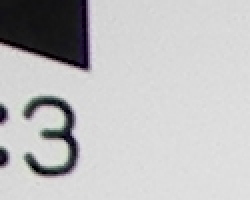 |
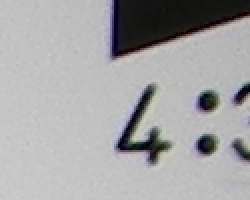 |
| Wide: nearly nonexistent, top left, 200% | Wide: very low, top right, 200% |
Chromatic aberration is very low, showing less than three faint pixels of coloration at wide angle. (This distortion is visible as a very slight colored fringe around the objects at the edges of the field of view on the resolution target.)
Corner Sharpness
Just a hint of softening in the top right corner of the frame, though sharpness is consistent throughout the rest of the frame.
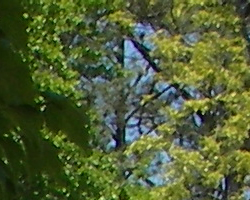 |
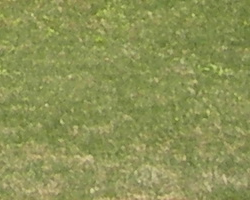 |
| Slightly soft in the upper right corner. | Better sharpness in lower right corner. |
The Optio WP produced consistent sharpness from corner to corner, though some very slight blurring was noticeable in the upper right corner. Still, great results.
Sensor
Exposure and White Balance
Indoors, incandescent lighting
Good results with the Manual white balance setting, though slightly cool, and higher than average exposure compensation required.
| Auto White Balance +1.3 EV | Incandescent WB +1.3 EV |
| Manual White Balance +1.3 EV |
Color balance indoors under incandescent lighting was warm and reddish in Auto white balance mode, though results were better with the Incandescent and Manual settings. The Manual option is technically correct, but appears slightly cool overall. On the other hand, the Incandescent setting is a bit yellow, but may be more appealing to consumers because it preserves more of the mood of the scene. The Optio WP required a +1.3 EV exposure compensation boost to get a good exposure, which is just a little higher than average. Still, results are quite good. Overall color is slightly dark, and the blue flowers are dark and purplish, but colors are still vibrant overall. Our test lighting for this shot is a mixture of 60 and 100 watt household incandescent bulb, a pretty yellow light source, but a very common one in typical home settings here in the US.
Outdoors, daylight
Good color balance, very bright colors. Pretty good exposure accuracy as well.
| Auto White Balance, +1.3 EV | Auto White Balance, Auto Exposure |
The Sunlit Portrait above is a little blown out at +1.3 EV, though the lower exposure at +1.0 EV was just a little too dim overall. However, the outdoor house shot to the right looks pretty good, despite some high contrast. Highlights and shadows lost some detail, limiting the camera's dynamic range. Overall, the Optio WP tends to underexpose high-contrast images, but the combination of exposure compensation and the camera's contrast adjustment should handle most average conditions well.
See full set of test images with explanations
See thumbnails of all test and gallery images
Resolution
High resolution, 1,200 lines of strong detail.
Our laboratory resolution chart revealed sharp, distinct line patterns down to about 1,200 lines per picture height, with extinction at around 1,500. Use these numbers to compare with other cameras of similar resolution, or use them to see just what higher resolution can mean in terms of potential detail. Beware that while you might be able to make out what looks like distinct lines at numbers higher than those we've mentioned here, the camera is just doing its best to continue interpreting the lines. If you zoom in and follow them from the wider portions, you'll see the lines converge and reappear several times, so the lines you see at 1,500 and higher are really only artifacts generated by the camera's imaging system.
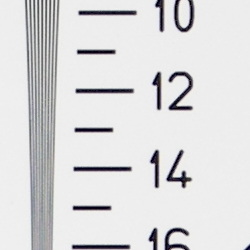 |
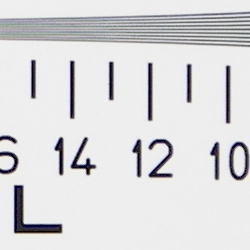 |
| Strong detail to 1,200 lines horizontal | Strong detail to 1,200 lines vertical |
See full set of test images with explanations
See thumbnails of all test and gallery images
Sharpness & Detail
Slightly soft detail overall, even in high-contrast subjects, with moderate blurring of detail from noise suppression and moderate image noise as well.
The Optio WP's images are slightly soft overall, even in high-contrast subjects which typically suffer from over-sharpening or edge enhancement. (Edge enhancement creates the illusion of sharpness by enhancing colors and tones right at the edge of a rapid transition in color or tone.)
Noise-suppression systems in digital cameras tend to flatten-out detail in areas of subtle contrast. The effects can often be seen in shots of human hair, where the individual strands are lost and an almost "watercolor" look appears. The crop at far right shows this, with darker areas of Marti's hair showing only limited detail, even though individual strands are quite visible against her cheek in the uncropped image. Though some detail loss is from noise suppression, some also is from noise itself, which appears to blur finer details.
ISO & Noise Performance
Moderate noise at the normal sensitivity settings, very high noise that blurs detail at the highest settings.
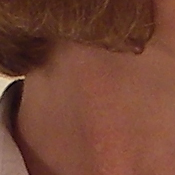 |
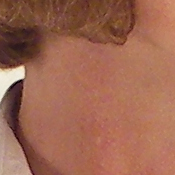 |
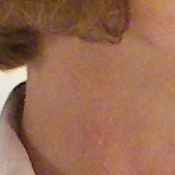 |
| ISO 50 | ISO 100 | ISO 200 |
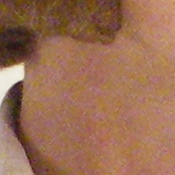 |
||
| ISO 400 |
The Optio WP's lower ISO settings produced moderate noise, with moderately blurred detail in the dark areas. Exposure also was notably darker at ISO 50, as opposed to ISO 200 and 400. At ISOs 200 and 400, noise is much higher, with stronger blurring in the fine details and bright pixels that alter the overall color balance.
Extremes: Sunlit and low light tests
High resolution with good overall detail, though high contrast and limited shadow detail. Pretty good low-light performance, capable of capturing bright images under average city street lighting and slightly darker conditions.
| +0.7 EV | +1.0 EV | +1.3 EV |
Sunlight:
Because digital cameras are more like slide film than negative film (in that they tend to have a more limited tonal range), we test them in the harshest situations to see how they handle scenes with bright highlights and dark shadows, as well as what kind of sensitivity they have in low light. The shot above is designed to mimic the very harsh, contrasty effect of direct noonday sunlight, a very tough challenge for most digital cameras. (You can read details of this test here.)
The Optio WP had a little trouble with the deliberately harsh lighting in the test above, producing very high contrast with washed-out highlights and deep shadows. Shadow detail was moderate, but a little noisy, and highlights were completely blown out. Though the exposure at +1.0 EV has better overall highlights, the +1.3 EV shot renders more detail in the face. (In "real life" though, be sure to use fill flash in situations like the one shown above; it's better to shoot in the shade when possible.)
Low light:
The Optio WP captured bright, colorful images at light levels as low as 1/4 foot-candle, about 1/4 as bright as typical city street lighting at night, at ISOs 200 and 400. At ISO 100, images were bright to about 1/2 foot-candle, and at ISO 50, images were only bright to about one foot-candle. Still, the Optio WP should be capable enough for most average consumer needs. Color balance looked pretty good with the Auto white balance setting. The camera's autofocus system worked well to about 1/4 foot-candle, which is all you really need for this camera's capabilities.
Color
Saturation & Hue Accuracy
Slightly oversaturated reds and blues, though still pleasing overall. Generally good hue accuracy.
The other important part of color rendition is hue accuracy. Hue is "what color" the color is. Here, the Optio WP again performed fairly well. The blue flowers in the bouquet of the Indoor and Sunlit portraits did have a dark, purplish cast, but overall color was still quite pleasing.
Our random "Gallery" shots showed very pleasing color across a wide variety of subjects. (See our Pentax Optio WP Photo Gallery for more shots taken with the camera.)
Viewfinder
Coverage
An accurate LCD monitor.
| 38mm eq., LCD monitor | 114mm eq., LCD monitor |
The Optio WP's LCD monitor proved very accurate, showing about 98% of the frame at both wide angle and telephoto zoom settings. Since I generally prefer LCD monitors to be as close to 100% frame accuracy as possible, the Optio WP performs pretty well here.
Flash
Coverage and Range
The Optio WP's flash has a limited range, and required more exposure compensation than average.
| 38mm equivalent | 114mm equivalent |
| Normal Flash +1.7 EV | Soft Range Flash Mode, +1.7 EV |
Flash coverage was uneven at wide angle. At telephoto, coverage was a little more even, but intensity was quite low. In the Indoor test, the flash on the Optio WP underexposed our subject quite a bit at its default setting, requiring a +1.7 EV exposure compensation adjustment to get bright results. The camera's Soft Range flash mode also required a +1.7 EV exposure boost, though results appear less harsh than with the normal flash mode.
Even at eight feet, our closest test range, the Optio WP's flash didn't adequately illuminate the Davebox target.
| 8 ft | 9 ft | 10 ft | 11 ft | 12 ft | 13 ft | 14 ft |
| 1/60 sec f4.0 ISO 50 |
1/60 sec f4.0 ISO 50 |
1/60 sec f4.0 ISO 50 |
1/60 sec f4.0 ISO 50 |
1/60 sec f4.0 ISO 50 |
1/60 sec f4.0 ISO 50 |
1/60 sec f4.0 ISO 50 |
Output Quality
Print Quality
Good print quality, great color, very usable 11x14 inch prints at low ISO. ISO 400 images are unacceptable at 8x10, and still poor at 4x6.
Testing hundreds of digital cameras, we've found that you can only tell just so much about a camera's image quality by viewing its images on-screen. Ultimately, there's no substitute for printing a lot of images and examining them closely. For this reason, we now routinely print sample images from the cameras we test on our Canon i9900 studio printer, and on the Canon iP5200 here in the office. (See the Canon i9900 review for details on that model.)
With the Pentax Optio WP, we found that it had enough resolution to make very crisp 8x10 inch prints when photos were taken at low ISO, but not so great as you reach the top of the ISO scale. At 11x14, its prints were a bit softer looking, but more than adequate for wall or table display. At high ISO, image noise levels are held in check, but at the cost of rather soft-looking images. ISO 200 photos look good printed at 8x10 inches, but ISO 400 images are unacceptable even at 4x6: color is washed out, and tones and textures appear artificial.
Timing and Performance
Pentax Optio WP Timing
Slightly lower than average speed.
| Startup/Shutdown: | |
| Power On to first shot | 2.4 seconds |
| Shutter response (Lag Time): | |
|
Full Autofocus Wide |
0.92 second |
|
Full Autofocus Tele |
1.16 second |
|
Prefocused |
0.149 second |
|
Cycle time (shot to shot) |
|
| Normal large/fine JPEG | 2.3 seconds |
| Normal small/basic JPEG | 2.23 seconds |
| Flash recycling | 6 seconds |
| Continuous mode | 1.27 second 0.79 frames/second (6 large/fine frames) |
| Download speed | |
| Windows Computer, USB 2.0 | 751 KBytes/sec |
The Optio WP's performance ranges from close to average to a little slow. Start-up time is a little behind, as are autofocus times at wide angle and telephoto. However, prefocusing the camera by halfway pressing the shutter button cuts the time down to 0.92 second, which is still a little slower than average. Shot-to-shot cycle times are also on the slow side, at 2.3 seconds for large/fine JPEG files. The camera's Continuous shooting mode may be continuous-capture, but definitely isn't speedy at 1.27 second frame intervals, or 0.79 frames per second for six large/fine files. However, the Optio WP's download speeds are fast enough that you probably won't feel a need for a separate card reader, at 751K per second.
Battery and Storage Capacity
Decent battery life for the camera's size; could not test due to proprietary connector.
|
|
|
| Still-image capture mode 50% flash usage |
180 images |
| Image playback |
230 minutes |
The Pentax Optio WP uses a custom rechargeable D-L18 3.7V, 710 mAh LiIon battery for power. The table above shows what the manufacturer estimates as runtime in accordance with CIPA standard measuring conditions. As always, you should definitely consider purchasing a second battery to pack along on extended outings.
Storage
The Optio WP features 10.5MB of internal memory, but is also compatible with SD memory cards.
|
10.5MB Internal Memory |
Fine | Normal | Economy | |
| 2,560 x 1,920 | Images | 3 | 6 | 10 |
| File Size | 3.4MB | 1.7MB | 1.0MB | |
| 2,304 x 1,728 | Images | 4 | 8 | 11 |
| File Size | 2.5MB | 1.4MB | 950K | |
| 2,048 x 1,536 | Images | 5 | 9 | 14 |
| File Size | 2.0MB | 1.1MB | 785K | |
|
|
Images | 8 | 15 | 20 |
| File Size | 1.2MB | 737K | 540K | |
|
|
Images | 18 | 33 | 42 |
| File Size | 589K | 327K | 262K | |
|
|
Images | 39 | 61 | 75 |
| File Size | 278K | 180K | 147K | |
I strongly recommend buying at least a 128MB card, preferably a 256MB one, to give yourself extra space for extended outings.
| Pro: | Con: |
|---|---|
|
|
| Free Photo Lessons | |
|
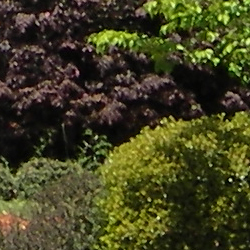
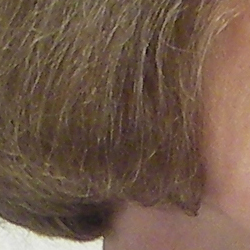


Follow Imaging Resource: